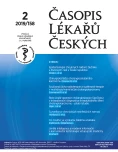-
Medical journals
- Career
Molecular pathology of cholangiocellular carcinomas
Authors: Libor Staněk 1,2,3; Robert Gürlich 1; Jan Hajer 4; Martin Oliverius 1; Renata Soumarová 5 5
Authors‘ workplace: Chirurgická klinika 3. LF UK a FN Královské Vinohrady, Praha 1; Ústav histologie a embryologie 1. LF UK v Praze 2; Vysoká škola zdravotnictví a sociální práce sv. Alžběty v Bratislavě 3; 2. interní klinika 3. LF UK a FN Královské Vinohrady, Praha 4; Onkologická klinika 3. LF UK a FN Královské Vinohrady, Praha 5
Published in: Čas. Lék. čes. 2019; 158: 64-67
Category: Review Article
Overview
Cholangiocellular carcinoma is a relatively rare malignant tumor, originating from cholangiocytes, with poor prognosis and late diagnosis. It is a malignancy with a variable biological etiology, numerous genetic and epigenetic changes. Its incidence in the Czech Republic is about 1.4 per 100,000 people per year.
For good prognosis and long-term survival, early diagnosis with surgical treatment is important. In these cases, a 5-year survival rate is about 20-40 %. In the early diagnosis imaging methods and histopathological verification play an essential role, whereas laboratory oncomarkers are not yet sufficiently accurate. The same applies for genetic markers. This leads to the search of new molecular targets and the high effort in the introduction of cytological and molecular-biological methods with high specificity and sensitivity into routine practice. Current early diagnosis is based on the use of efficient imaging methods.
The use of genetic testing, and especially knowledge of the molecular basis of this disease, will be of a great benefit. The observation of the association between the genetic pathways, IDH1, RAS-MAPK etc., and genetic mutations of genes, such as TP53, KRAS, SMAD4, BRAF, IDH1/2, may be significant. From the molecular point of view, it is also interesting to monitor oncogenic potential in HBV/HCV infection.
Keywords:
cholangiocellular carcinoma – oncomarkers – mutation of genes – KRAS – p53
Sources
- Aherne EA, Pak LM, Goldman DA et al. Intrahepatic cholangiocarcinoma: can imaging phenotypes predict survival and tumor genetics? Abdom Radiol 2018; 43(10): 2665–2672.
- Honsová E. Histopathological diagnosis of hepatocellular carcinoma. Gastroent Hepatol 2012; 66(2): 93–98.
- Bělina F. Hilový cholangiokarcinom (Klatskinův tumor) – současné možnosti léčby. Rozhl Chir 2013; 92(1): 4–15.
- Rydlo M, Dvořáčková J, Kupka T et al. The rational diagnostic of cholangiocarcinoma. Vnitř Lék 2016; 62(2): 125–133.
- Zhou H, Xu J, Wang S, Peng J. Role of cantharidin in the activation of IKKα/IκBα/NF-κB pathway by inhibiting PP2A activity in cholangiocarcinoma cell lines. Mol Med Rep 2018; 17(6): 7672–7682.
- Patočka J, Kuča K. Kantaridin: přírodní bioaktivní molekula s dlouhou historií. Kontakt 2013; 15 : 463–469.
- Qian F, Guo J, Jiang Z, Shen B. Translational Bioinformatics for Cholangiocarcinoma: opportunities and Challenges. Int J Biol Sci 2018; 22; 14(8): 920–929.
- Hill MA, Alexander WB, Guo B et al. KRAS and Tp53 mutations cause cholangiocyte - and hepatocyte-derived cholangiocarcinoma. Cancer Res 2018; 15; 78(16): 4445–4451.
- Zhong W, Dai L, Liu J, Zhou S. Cholangiocarcinoma‑associated genes identified by integrative analysis of gene expression data. Mol Med Rep 2018; 17(4): 5744–5753.
- Wang J, Zhang ZG, Ding ZY et al. IDH1 mutation correlates with a beneficial prognosis and suppresses tumor growth in IHCC. J Surg Res 2018; 231 : 116–125.
- Moeini A, Sia D, Bardeesy N et al. Molecular pathogenesis and targeted therapies for intrahepatic cholangiocarcinoma. Clin Cancer Res 2016; 15; 22(2): 291–300.
- Liu ZH, Lian BF, Dong QZ et al. Whole-exome mutational and transcriptional landscapes of combined hepatocellular cholangiocarcinoma and intrahepatic cholangiocarcinoma reveal molecular diversity. Biochim Biophys Acta Mol Basis Dis 2018; 1864 : 2360–2368.
- Akita M, Sofue K, Fujikura K et al. Histological and molecular characterization of intrahepatic bile duct cancers suggests an expanded definition of perihilar cholangiocarcinoma. HPB (Oxford) 2019; 21(2): 226–234.
- Sia D, Hoshida Y, Villanueva A et al. Integrative molecular analysis of intrahepatic cholangiocarcinoma reveals 2 classes that have different outcomes. Gastroenterology 2013; 144(4): 829–840.
- Yang B, Tong R, Liu H, et al. H2A.Z regulates tumorigenesis, metastasis and sensitivity to cisplatin in intrahepatic cholangiocarcinoma. Int J Oncol 2018; 52(4): 1235–1245.
- Nanok C, Jearanaikoon P, Proungvitaya S, Limpaiboon T. Aberrant methylation of HTATIP2 and UCHL1 as a predictive biomarker for cholangiocarcinoma. Mol Med Rep 2018; 17(3): 4145–4153.
- Mosbeh A, Halfawy K, Abdel-Mageed WS et al. Nuclear BAP1 loss is common in intrahepatic cholangiocarcinoma and a subtype of hepatocellular carcinoma but rare in pancreatic ductal adenocarcinoma. Cancer Genet 2018; 224–225 : 21–28.
- Moirangthem A, Wang X, Yan IK, Patel T. Network analyses-based identification of circular ribonucleic acid-related pathways in intrahepatic cholangiocarcinoma. Tumour Biol 2018; 40(9): 1010428318795761.
Labels
Addictology Allergology and clinical immunology Angiology Audiology Clinical biochemistry Dermatology & STDs Paediatric gastroenterology Paediatric surgery Paediatric cardiology Paediatric neurology Paediatric ENT Paediatric psychiatry Paediatric rheumatology Diabetology Pharmacy Vascular surgery Pain management Dental Hygienist
Article was published inJournal of Czech Physicians

2019 Issue 2-
All articles in this issue
- Epidemiology of gallbladder and bile duct malignancies in the Czech Republic
- Pathology of cholangiocellular carcinoma
- Molecular pathology of cholangiocellular carcinomas
- The role of single-operator cholangioscopy (SpyGlass) in the intraoperative diagnosis of intraductal borders of cholangiocarcinoma proliferation – pilot study
- Surgery for cholangiocarcinoma
- The current role of radiotherapy and systemic therapy in the multidisciplinary treatment of cholangiocarcinoma
- Surveillance of chronic noninfectious diseases
- Artificial intelligence and modern information and communication technologies entering medicine
- Journal of Czech Physicians
- Journal archive
- Current issue
- Online only
- About the journal
Most read in this issue- Surgery for cholangiocarcinoma
- Pathology of cholangiocellular carcinoma
- Epidemiology of gallbladder and bile duct malignancies in the Czech Republic
- Artificial intelligence and modern information and communication technologies entering medicine
Login#ADS_BOTTOM_SCRIPTS#Forgotten passwordEnter the email address that you registered with. We will send you instructions on how to set a new password.
- Career

